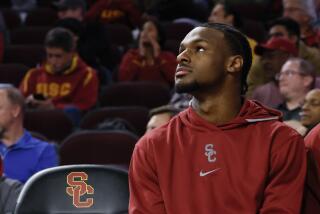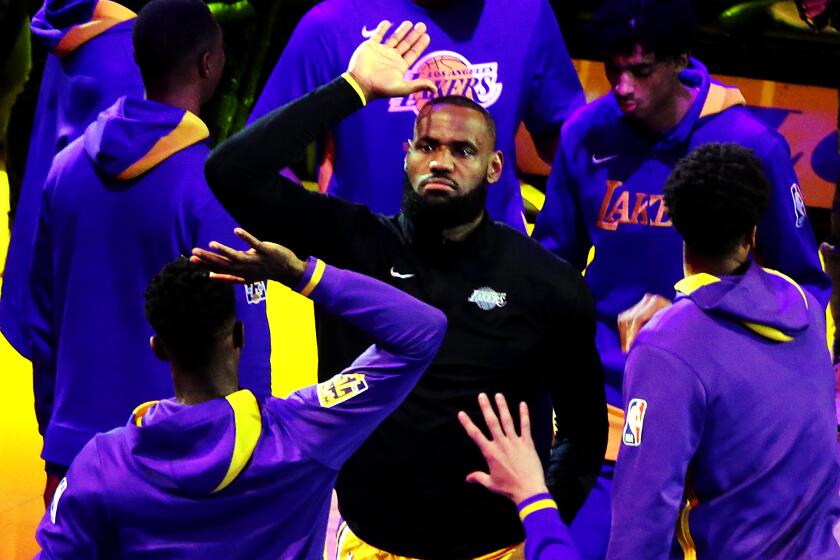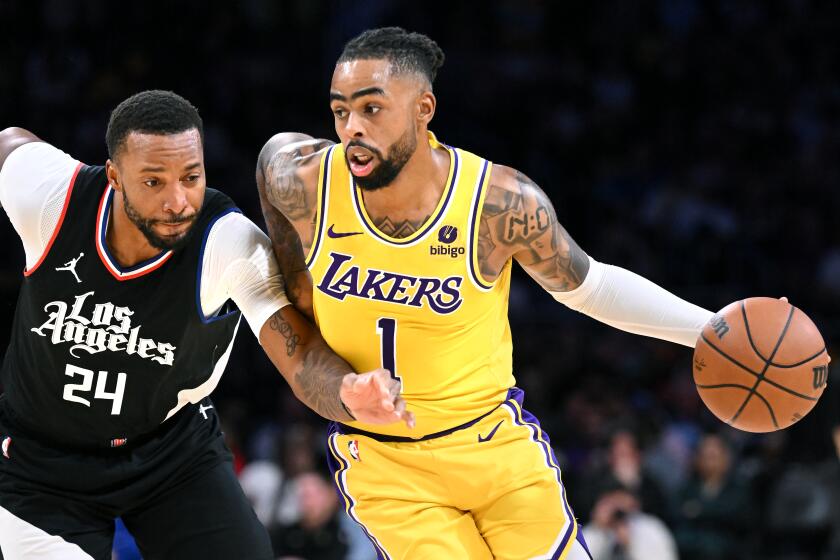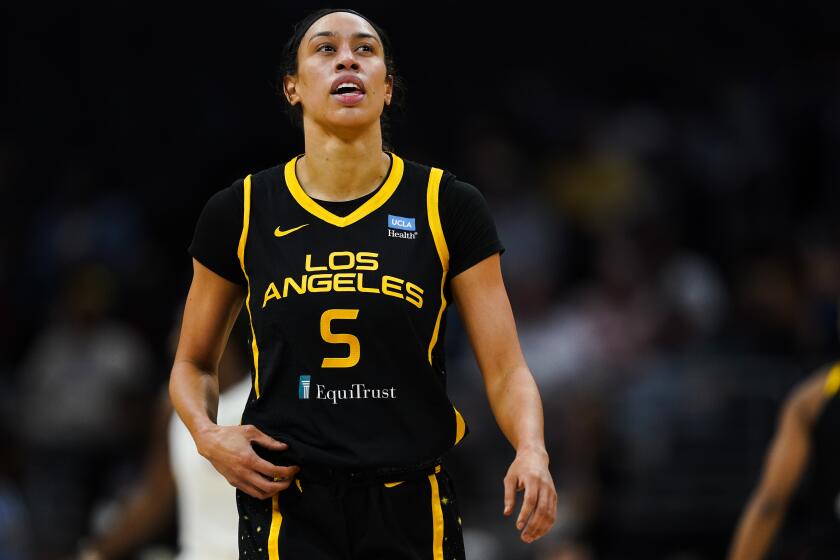WHO’S BEEN MINDING THE FARM? : Robinson Says Orioles Stopped Developing Championship Talent
The collapse of the Baltimore Orioles is reduced to basics by Frank Robinson.
“The talent is not there,” said the man who has been all things with the Orioles: player, coach, front-office executive and now manager. “It’s that simple.
“It used to be that the Orioles turned out talent on top of talent, then went out and traded for that one particular player.
“When you have to do what they’ve done in the last few years, when you have to fill four or five positions every year, you’re not going to be successful. You’re not going to have the same stability and execution.”
Added Robinson: “I wasn’t on the inside and I don’t want to point fingers, but we haven’t had an impact player since Cal Ripken arrived in 1982, and we haven’t had an impact pitcher since Mike Boddicker in 1983.
“We seemed to have signed a lot of designated-hitter types like Larry Sheets.
“I still go out thinking we can win, but knowing that in most cases the other club has more talent. That’s just a fact, particularly in our division.
“On given days, at given times, we can beat the Yankees, Blue Jays and the other teams in the East, but day in and day out, we can’t compete with them, we can’t match up with them.”
Robinson is not alone in his analysis.
A variety of sources say that farm-system breakdowns and front-office bickering helped plunge the Orioles to uncharted depths faster, perhaps, than any other successful organization in baseball history.
The Oriole way was the textbook example in the American League.
Consider that in the 21 seasons from 1964 through 1985, excluding the strike-interrupted season of 1981, the Orioles won 7 division titles, 6 pennants and 3 World Series championships.
They won 100 or more games 5 times in that period, 90 or more 16 times, and averaged 94 wins a season. Only once, in 1967, did they finish under .500, and their record in the 19 years of division play is baseball’s best.
But starting in 1984, when they won 85 games and finished fifth in the East in defense of their last World Series title, they have descended faster than the fog on Chesapeake Bay.
They were 83-78 in 1985, 73-89 in 1986 and 67-95 last season, when they finished 31 games out; had the highest earned-run average in club history, 5.01; experienced the worst single month in club history, 5-23 in June; became the first major league team to hit 200 or more homers and give up 200 or more in the same season; were forced to use 23 players who spent part of the season in triple-A; and started 63 games with rookie pitchers.
Were those pitchers ready? The evidence suggests not. The rookies were 27-40. Thirty-five times a Baltimore starter pitched three innings or fewer, an embarrassing performance for an organization that produced Jim Palmer, Dave McNally, Wally Bunker, Mike Flanagan and Dennis Martinez, among others.
The Orioles, in fact, had at least one 20-game winner every season from 1968 through 1980, but have had only three in this decade, which is one fewer than they had in 1971 alone.
Now there is no apparent stopper among the five starters and no real basis for hope, considering that they totaled only 24 victories last season.
Boddicker led that staff with 10, but the 10th is quickly fading from memory. He is 0-4 in 1988 and has lost his last nine decisions.
Fellow veteran Scott McGregor, the one-time ace and heir to the Orioles’ pitching legacy, is 13-25 in the last two-plus seasons and is reportedly being retained only because he has two seasons left on a lucrative contract.
Mike Morgan, who lost 17 games in each of the last two seasons, seems to be the bellwether, a suspect link to a rich tradition.
Morgan was obtained in a winter trade with the Seattle Mariners.
There was a time when the Orioles, producing that talent on top of talent, had to make only the occasional trade. They dealt from strength then, filling their occasional needs with Frank Robinson, Mike Cuellar, Ken Singleton, Mike Torrez . . .
Now, since September, there are 13 new faces on a 24-player roster that includes only 8 farm products. Of the 10 active pitchers, only Boddicker was produced by the Baltimore system.
Is it really any wonder that the Orioles are 79-154 since Aug. 6, 1986, that they are 27-98 against the East since September of that year and that they have opened the 1988 season with 15 straight losses, a major league record?
Even more to the point, the questions are: How did it happen? Where did the Orioles go wrong?
League and club sources cite the following:
--The Orioles paid an inevitable price for their consistent success in that they were annually forced to draft near the bottom in the June selection of high school and college players.
The consistent success also attracted other clubs--and in some cases, the Orioles responded cheaply.
The Angels, for instance, lured away General Manager Harry Dalton after the 1971 season, and Dalton took the top echelon of his farm and scouting staffs with him.
Club president Frank Cashen, now with the New York Mets, left after the 1975 season, and Cashen took Lou Gorman, now general manager of the Boston Red Sox, and Joe McIlvaine and Al Harazin, now Met vice presidents, with him.
John Schuerholz left Baltimore and eventually became general manager of the Kansas City Royals. George Bamberger and Ray Miller, highly regarded pitching coaches left to become managers, as did coaches Jim Frey and Billy Hunter.
There was suddenly a bidding war for the top Baltimore scouts, and many, such as Bob Engel, now with Toronto, took the money and ran.
Said Dalton, now general manager of the Milwaukee Brewers: “What shouldn’t be forgotten is that the Orioles were built in a 16-team major league structure and are now being rebuilt in a 26-team structure in which the playing, scouting and administrative talent is much thinner.
“If we have the same success that the Orioles had, it will catch up with us, too. You can’t consistently draft 23rd or lower.
“The Orioles experienced a talent drain at all levels, and in this game it doesn’t take long to go from the top to the bottom.”
--Compounding the low drafts and the loss of such stars as Bobby Grich, Reggie Jackson and Don Stanhouse to free agency, the Orioles have had a series of bad drafts and no drafts.
Since 1976, for example, Baltimore’s first-round choices have played only 26 major league games, and it is generally conceded that the club has not selected a complete player since Cal Ripken Jr. in 1978.
In addition, the Orioles have paid a high compensatory price for owner Edward Bennett Williams’ foray into free agency. The signings of Fred Lynn, Don Aase and Lee Lacy alone cost the Orioles three of their top five picks in the 1985 draft.
Said one American League general manager, requesting anonymity: “The Orioles might have offset much of that by aggressively pursuing the Latin market, which is not governed by the draft, but they have failed to do that as well.”
There is also a conspicuous absence of black players in the Orioles’ farm system. A survey authorized by Williams last year disclosed that only 7 of the 100 minor league players under contract to the club were black, a situation that is expected to change as part of the most aggressive affirmative action program in baseball.
--Undermining the farm system and the redevelopment of a consistent policy at the top was a reportedly divisive series of confrontations between Williams, the famed Washington attorney, and General Manager Hank Peters.
Peters, for example, is said to have disagreed with Williams’ decision to fire Joe Altobelli only a year after he led the Orioles to the 1983 World Series title. Williams felt that Altobelli lacked fire and intelligence--the owner was said to be shocked when Altobelli bragged about having read only one book in his life, that of a hockey player--and chose to bring back Earl Weaver, the marquee name whose zeal was redirected toward his bank account.
Weaver proved to be a mistake and stayed only one year. He was replaced by Cal Ripken Sr., Peters’ choice, as had been Altobelli, and a similar grass-roots baseball man. Ripken was the third of the four managers the Orioles have employed in the 5-plus years since Weaver’s first retirement.
In addition, Peters is said to have objected to the acquisition of Lynn, Aase and Lacy for $11.2 million; the decision to acquire Alan Wiggins, who had a $2.8-million contract and a drug history that soon surfaced again, and the subsequent signings of free agents Rick Burleson and Ray Knight.
Was this rebuilding or refurbishing? What was the philosophy and direction?
Now only Lynn and Aase remain.
Robinson reflected on the signings and said:
“I give them credit for wanting and trying to win, that’s what the game is all about. If you win at the top, a lot of things can be overlooked, like the state of the farm system. I also think that the owner may have been told that the foundation was better than it was.”
In his public comments, Williams has said that he knew the farm system was in bad shape, which is why he signed the free agents.
Peters and others, however, have suggested that Williams was looking for a quick fix, putting his money in the wrong place and acting, perhaps, out of an impatience born of his long battle with cancer.
The situation was eased the day after the 1987 season ended when Williams fired Peters and farm director Tom Giordano, naming Roland Hemond and Doug Melvin as their replacements, and also elevating Robinson from coach to assistant general manager.
Peters, who subsequently became general manager of the Cleveland Indians, did not return phone messages relating to this article.
Williams, at the October press conference, borrowed a phrase from Winston Churchill when he said of the front-office changes, “This is not the beginning of the end but the end of the beginning.”
However, it was not until Robinson replaced Ripken--who reportedly and surprisingly turned out to be a soft-willed players’ man--after the first six losses of the new season that Williams had all of his own people in place for the first time since buying the club Nov. 1, 1979.
Now, said one club official, there is a new confidence, a new unanimity in the front office. Nevertheless, there are obvious problems, including a basic need to overcome the simple bad luck that has complicated all of the aforementioned factors.
Injuries and illness have deprived the Orioles of the services of, or led to the departure of, pitchers Aase, Flanagan, McGregor, Dennis Martinez and Tippy Martinez, among others. Flanagan and Dennis Martinez, as their current success with the Blue Jays and Montreal Expos would indicate, may have been traded prematurely.
“It’s hard to replace five or six pitchers at one time,” said Hemond, the former Angel farm director and general manager of the Chicago White Sox.
“That, more than anything, has been the major problem. It’s also hard to maintain a consistency forever, drafting as low as the Orioles were.
“When you have two or three bad drafts on top of it, other clubs start to pass you.”
Hemond said his immediate goal is to stabilize the farm system and stop the force-feeding, giving some of the pitchers who worked at the major league level last year a chance to put in a full season in triple-A.
Alluding to the major league nucleus of Ripken, Lynn, Sheets, Eddie Murray and Terry Kennedy, he said: “I didn’t feel coming in that we had to go through a rebuilding process. With that kind of nucleus, I felt we could be competitive by supplementing it some.
“I still do. If we had hit like we can, we wouldn’t have had the losing streak and we might not even be having this kind of discussion. We were the victim of a team-wide hitting slump that has since put pressure on the pitchers.”
In other words, Hemond would seem to be disagreeing with Robinson. He would seem to be saying that the Orioles have enough talent to be competitive, ignoring significant questions about the pitching and defense, to name just two of the potential problems.
“Yes,” he said. “I’m saying that I don’t believe in long-range plans. I’m saying, ‘Let’s go to work and get it done as soon as possible.’ I start with a clean slate. I’m not interested in the nit-picking that may have gone on before. I haven’t even asked about it.
“This was one of the great organizations in baseball, one I always admired and worked toward emulating. It knew how to win. It knew how to develop and utilize talent.
“I think we can reach that level again without taking five years in the process.”
The immediate problem is 1988. It figures to be the longest year ever for all of the Orioles.
“I feel as much pressure as I’ve felt. I feel the kind of pressure that I felt on clubs in pennant races,” Lynn said after Thursday’s 15th straight loss. “There’s not just a monkey on our back, it’s Godzilla.”
More to Read
Get our high school sports newsletter
Prep Rally is devoted to the SoCal high school sports experience, bringing you scores, stories and a behind-the-scenes look at what makes prep sports so popular.
You may occasionally receive promotional content from the Los Angeles Times.






